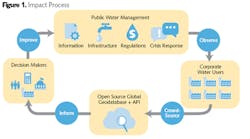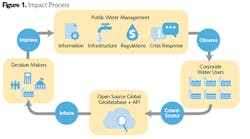A New Take on Risk
Industrial facilities are placing more emphasis on water as a business driver and the development of a global water management database promises to help improve water risk assessments
By Jeff Gunderson
In the face of mounting global water stress and supply uncertainty, industrial operators are becoming increasingly aware of the need to address their water-related risks for ensuring long-term water security. More than adding increased costs, supply shortages can cause financial losses, disrupt supply chains, cause facilities to sit idle, or even force companies to shut down operations.
It’s no surprise that for the past six years, business leaders have identified “water crises” as among the top five global risks in terms of impact, according to the World Economic Forum’s Global Risks Reports from 2013-2018, in which experts and decision-makers annually identify and analyze the most pressing risks.
According to WRI and MIT, improving public water management is contingent upon putting actionable information into the hands of decision-makers and developing a dynamic process to drive long-term improvements in water management. Image credit: WRI/MIT Sloan School of Management Sustainability Initiative.
PricewaterhouseCoopers (PwC), a multinational professional services network headquartered in London, has called water “the most problematic of resources” and deserving of a place on the risk agenda for every business. But since water-related risks are not always understood or quantified, PwC says operations are often exposed to potential impacts: “When things go wrong, not only is production at stake, reputation and license to operate are too ... so the decisions around water have far-reaching consequences.”
To strengthen the resilience to water-related challenges, PwC recommends that companies identify and understand how water risks can impact operations and growth strategies, and then act to reduce and better manage water across all aspects of an operation.
Water Risk Becoming a Bigger Project Driver
Dave Sobeck, senior vice president of Carollo Engineers, an environmental engineering firm specializing in the planning, design, and construction management of water and wastewater facilities, said manufacturers in recent years have begun to think differently in the way they approach water challenges and mitigate water risks.
“As the cost of water and managing its use has increased, and as water scarcity has developed into a larger concern, water has become more of a business driver across many manufacturing sectors,” Sobeck said. “We’ve started to see facilities implement water metrics as a component of their operational and business models. They want to understand more holistically how much water it takes to make a product, how that is impacting their bottom line, and how they can better manage this increasingly critical resource. That’s something we haven’t seen in the past.”
Traditionally, making a business case for industrial water savings strategies has proved difficult to rationalize from a cost return perspective. In 2016, the U.S. Department of Energy (DOE) released a report detailing the lessons learned from a water savings pilot in which the DOE worked with a select group of manufacturers to better understand key details of their successful water management efforts, including the motivating factors behind their strategies.
Corporate water users collect information on public water management in standardized facility water risk assessments. WRI is working with the Pacific Institute to crowdsource this information and make it accessible in an open-source geodatabase. Image credit: WRI/MIT Sloan School of Management Sustainability Initiative.
The findings revealed that the low cost of water causes many water saving projects to fall outside of a company’s typical allowable payback period. But at the same time, the report also found that avoided risk can be a consideration for companies in justifying water saving projects and that costs are not always a driver — indeed, many are strategically installed to address local regulations or water availability concerns.
“Once the availability or cost of water starts to impact the bottom line or prevent companies from meeting their growth targets, the focus suddenly turns to addressing that risk,” Sobeck said. “This is driving facilities to implement water recycling or water efficiency measures to allow them to meet their growth goals, sustainability drivers, or business objectives. We’ve seen this occurring in a more meaningful way in recent years.”
Crowdsourcing Water Management Data
To evaluate the business risk of water to a manufacturing or processing operation much needs to be understood regarding the water balance of a facility as well as the regional conditions and environmental constraints that can influence the facility’s water supply. But according to the World Resources Institute (WRI) and Massachusetts Institute of Technology (MIT) Sloan School of Management Sustainability Initiative, the physical components of water supply — its abundance or scarcity, levels of pollution, and the competition over it — are only half of the equation when it comes to overall water security. What’s equally as important is the way in which water is managed locally by governments and utilities.
“How governments respond to water crises, maintain their water infrastructure, and regulate users can be just as threatening to water security as a drought or flood,” according to Paul Reig, WRI’s senior manager of Aqueduct and Corporate Water Stewardship. “You can identify water scarce environments but not how the local government handles that challenge.”
Although extensive data has been collected in relation to water availability and water quality, little is available about public water management. However, WRI and MIT identified that this information exists in corporate water risk assessments from around the globe. By accessing and consolidating this data and making it available through a global database, companies, investors, and industrial operators alike could make more informed water risk assessments.
Earlier this year, WRI and MIT released a new technical note describing how this data gap can be closed. The technical note, Mapping Public Water Management by Harmonizing and Sharing Corporate Water Risk Information, sets out to identify indicators that can help characterize and communicate the state of public water management in a comparable and comprehensive way and proposes that crowdsourcing mechanisms be employed to collect, share, and distribute the data generated by the indicators.
Colin Strong, corporate water stewardship analyst for WRI’s Water Program, said water management data combined with data on the physical aspects of water risk could provide manufacturers with a much clearer picture of their true water risk condition.
“As an example, if we could access data layers that identify all the places in the world where groundwater extraction permits are not required and then overlay that with information on regions experiencing groundwater stress, we could help companies identify locations where a lack of policy and water resource limitations are heading for a collision course,” Strong said. “If you are a global operation with sites in these locations, you’re going to need a very clear action plan to ensure that your facilities don’t become stranded assets.”
According to Strong, consistent water supply for an industrial site can depend as much on management as it does on physical resources. “Even if water is physically abundant, poor management — through eroding infrastructure, weak regulations and inadequate crisis response — could make water scarce for the end user. The reverse is also true: good management can keep water flowing even when supply is limited,” he said.
Currently, WRI is working in collaboration with the Pacific Institute to create the world’s first global comparable geodatabase of public water management practices.
About the Author: Jeff Gunderson is a correspondent for Industrial WaterWorld and a part-time faculty instructor at Portland State University, teaching in the Professional and Technical Writing program. He holds a master’s degree in Environmental Science and Engineering from the Colorado School of Mines and a bachelor’s degree in General Science from the University of Oregon.


